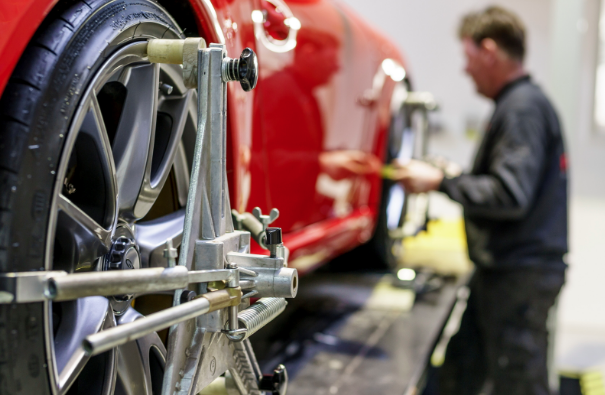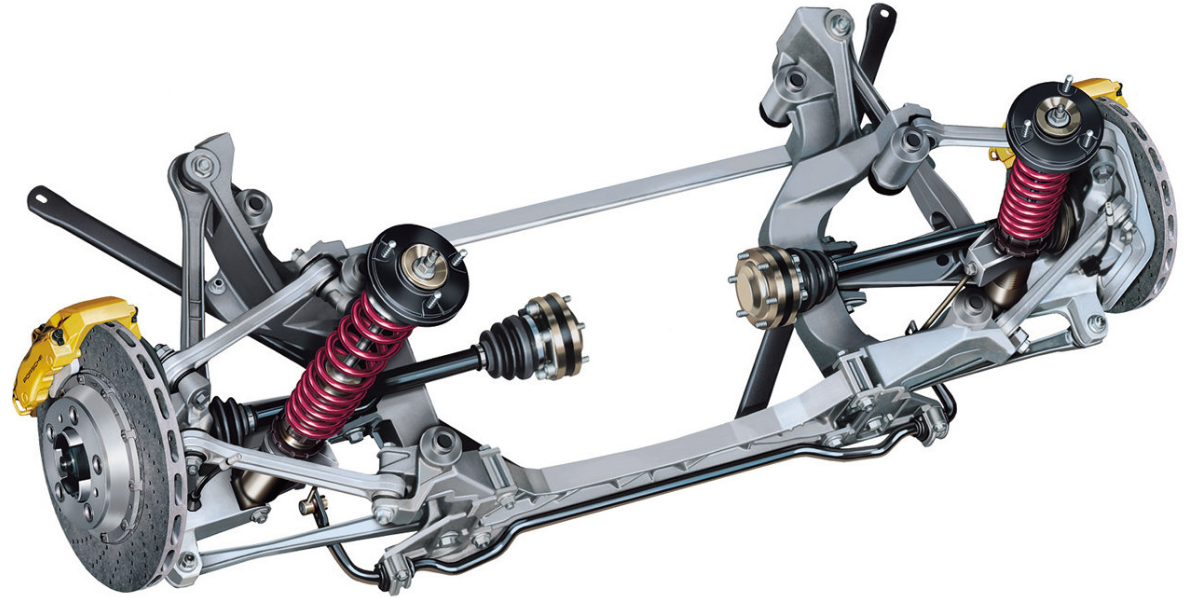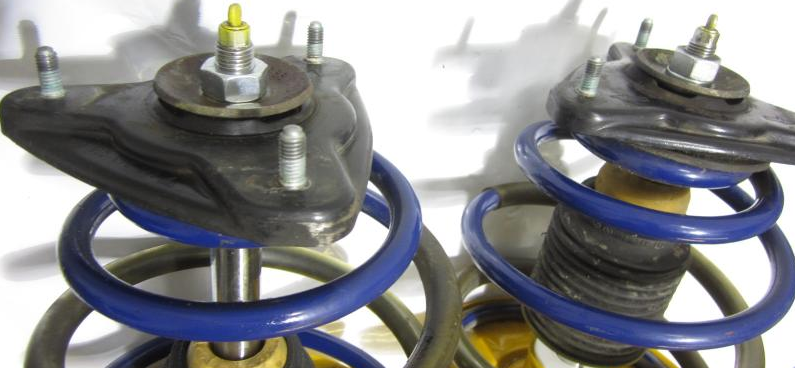AMS WHEEL ALIGNMENT ON PORSCHE SPORTS AND RACING CARS

In our company no "track adjustments" are carried out for 40 euros!
We carry out professional axle and chassis adjustments in a holistic manner with regard to the vehicle and the relevant components of the axle kinetics of your Porsche.
All important parameters are included in the measurement, thus eliminating errors in the technical environment from the outset.
What does this mean for working on a Porsche?
Before we measure and adjust the axle geometry, the following parameters on your Porsche are checked and, if necessary, adjusted and corrected; defective components are also replaced in advance.
The important preparatory work for axle geometry measurement is:
- Checking the tires and their air pressures.
- Checking the axle joints, axle supports, tie rods and joints.
- Checking the steering center plane, the steering deflection right and left.
- Checking the spring domes and the piston play of the shock absorbers.
- Checking the wheel bearings and their adjustment and bearing play.
- Checking the setting of the axle weights on our axle load scale.
- Check the screws on all supports, handlebars, stabilizers, etc.
- Checking rim runout, concentricity, radial runout, wheels and tires.
- Checking the steering stops on the steering gear
Only when all of these parameters mentioned above have been met and found to be "good",
we start with the actual wheel alignment and chassis adjustment.
 %20GT3% 20Cup%20Hinterachse.png" style="box-sizing: border-box; margin: 4px 0px 17px; padding: 0px; border: 0px #eff0f2; font-style: inherit; font-variant: inherit; font-weight: inherit; font-stretch: inherit; line-height: inherent; font-family: inherit; font-optical-sizing: inherit; font-kerning: inherit; font-feature-settings: inherit; font-variation-settings: inherit; vertical-align: middle; max-width: 100%; height: auto;" />
%20GT3% 20Cup%20Hinterachse.png" style="box-sizing: border-box; margin: 4px 0px 17px; padding: 0px; border: 0px #eff0f2; font-style: inherit; font-variant: inherit; font-weight: inherit; font-stretch: inherit; line-height: inherent; font-family: inherit; font-optical-sizing: inherit; font-kerning: inherit; font-feature-settings: inherit; font-variation-settings: inherit; vertical-align: middle; max-width: 100%; height: auto;" />
Before setting up, we ask our customers whether they would like to use the car in normal
Road operation, or a setting for mixed operation, or the pure pure
Sports operations e.g. for sporting events .
Accordingly, we then select the parameters to be set, taking into account
inspection of the tire brand and recommend it to our customers.
Before professional sports events, the sports and racing vehicles are
prepared that the driver weights are included in the measurement,
to optimally adapt the vehicles to the relevant driver.
All actual and target values are recorded by an input measurement,
and if necessary, readjusted during the work. Everything is checked before and
documented after the axle adjustment.
1.) The front axle
- Track (individual and total track, related to the geometric driving axis),
- Camber (when driving straight ahead or on zero track),
- Wheel offset, relative to the left front wheel,
- caster, spread and track difference angle
(determined jointly in an impact routine).
2. ) The rear axle
- Track (individual and total track, related to the vehicle
longitudinal median plane, formerly called axis of symmetry), - driving axle angle,
- fall
3. ) The axle geometry in relation to the body
- rear wheel offset
- wheelbase difference
- right side offset
- left offset
- track width difference
- axle offset
These additional measured values are only determined and can only be partially adjusted by adjustment work
be corrected, because damage caused by violence is usually the cause. Often
Straightening work is necessary if the values deviate too much from the permissible tolerances.
The basic rule is: If actual values are determined outside the tolerance, damaged
Parts are replaced and/or adjustments are carried out.
If the values are incorrect, the rear axle is always adjusted first and then the front axle.
It is important to know that the track of the rear axle has a noticeable influence on the track of the
The basic order is: first the caster, then
the camber, then the track. Because these values influence each other, in practice
This setting sequence has proven successful for us.

BACKGROUND KNOWLEDGE ON LOWERING AND MOUNTING WIDE TIRES
By simply lowering the body without any further changes, the
This then has negative effects on the driving behavior .
This change is at the expense of the negative steering roll radius . A positive steering roll radius
In addition to one-sided braking, this also results in the vehicle pulling strongly to one side.
By changing the suspension strut positions, the angle of spread also changes , it increases and influences
thus the steering radius becomes positive , which in turn affects the braking performance. In addition
the wheel load on the wheel bearing is increased, which increases wear on the wheel bearing.
By simply lowering the chassis, the camber also changes to a negative level. This affects
In turn, this also affects the steering radius and, as described above, also affects the braking
behavior.
In addition, this also results in a change in track , which has the known effects on tire wear,
on one-sided pulling of the vehicle, on faster steering in toe-in and poorer straight-line stability
can cause problems with toe-out.
The wheelbase is also changed by chassis installations. This improves driving comfort in a
long wheelbase. A longer wheelbase reduces the pitching of the vehicle and the rocking
on uneven road surfaces.
The caster changes to positive after installation. This has a positive effect on the restoring forces
of the vehicle, it is raised more on the outside of the curve. The camber is thus reduced on the cornering
outer side is more negative, which noticeably increases the supporting forces.
The wider tires provide better traction when starting and greater cornering safety,
which, however, is offset by the harder chassis.
In summary, it can be stated that when installing a lowering suspension, all wheel position
sizes can be influenced:
Track, camber, spread, caster, steering radius. Adjustments to the
Axle kinetics to generate a positive effect!
Simply installing harder springs can result in significant disadvantages for the driving behavior.
The problem is that in some Porsche vehicles not all parameters of the axle are adjustable. This
Structural changes would result in misalignments that can no longer be corrected.
A harder chassis has a significant negative impact on handling and roadholding
in general. This results in poorer grip when cornering, on uneven roads, when starting
Loss of traction and a noticeably increased risk of aquaplaning in the rain.
We have been working with the following formula for decades: "As soft as possible, as hard as necessary".
This applies equally to racing as well as to sports drivers at track days!
Best regards
Jürgen Albert



